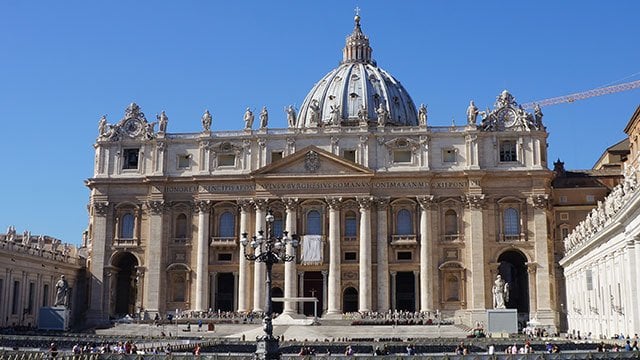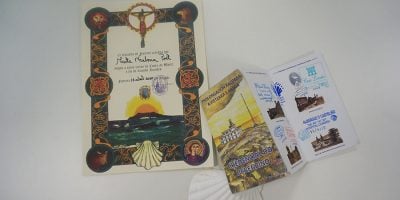Camino Pilgrim Passports & Certificates Explained
This guide breaks down the key differences between the various Camino Pilgrim Passports (Credencials) and the official certificates you can receive, including the well-known Compostela.
Table of contents
1. Traditional Camino Passport & Compostela Certificate
Many walk the Camino de Santiago for spiritual, personal, or social reasons. Regardless of your motivation, you’ll need a Pilgrim Passport (Credencial del Peregrino) to record your journey and qualify for a certificate at the end.

2. Pilgrim Passport – Credencial del Peregrino
This official document proves you’ve walked at least the last 100 km (or cycled 200 km) to Santiago. Collect two stamps per day from churches, town halls, or other approved locations along the route.
At the Pilgrim’s Office in Santiago, present your stamped passport to receive your certificate.
Where to get it:
Available from Camino support organizations (e.g., American Pilgrims on the Camino, Camino Society of Ireland), authorized Spanish associations, or at churches and shops along the route.
3. Compostela Certificate
The Compostela is the traditional religious certificate issued in Latin by the Church. It verifies you’ve completed the minimum distance for spiritual or religious reasons.
Historically, it replaced the scallop shell as official proof due to widespread fraud. During the Middle Ages, the Compostela served as evidence of penance and, symbolically, a ‘ticket to heaven.’
Even today, pilgrims showing their Compostela can receive free meals for three days at the Hostal dos Reis Católicos in Santiago (limited to 10 per day).
How to get it:
- Go to the Pilgrim’s Office in Santiago.
- Take a ticket and check your place in line via the QR code.
- You can wait or return later (recommended: 50 numbers before your turn).
- Group submissions are allowed if arranged in advance via a special form.
4. Camino Certificate of Distance
This Camino Certificate of Distance lists your starting point and total distance completed. It’s available in multiple languages for €3. You can receive this in addition to the Compostela.
Note: You must end your journey in Santiago to get any official Camino certificate.
5. Other Camino Pilgrim Passports
There are specific passports and certificates for other Camino routes beyond the main path to Santiago:
Finisterrana & Muxiana Certificates
If you continue past Santiago to Fisterra or Muxía, you can request a Finisterrana or Muxiana certificate.
If walking in reverse from Muxía to Santiago, you may qualify for the Compostela.
Celtic Camino Certificate
The Celtic Camino allows pilgrims from places like Ireland and the UK to combine a local 25 km walk with the 75 km Camino Inglés from A Coruña to reach the 100 km minimum. Approved trails include the Kerry Camino (Ireland) and St Michael’s Way (UK).
6. Via Francigena Passport & Testimonium Certificate
If walking the Via Francigena to Rome, you’ll need a Credenziali (pilgrim passport) to receive the Testimonium, the Vatican’s version of the Compostela.
Requirements:
- Complete the pilgrimage with your stamped passport.
- Collect your Testimonium at St. Peter’s Basilica or San Lorenzo Pilgrim Office in Rome.
For more information about Camino routes, documentation, or planning your journey, feel free to reach out.
FAQs: Camino Pilgrim Passports & Certificates
Q: Do I need a pilgrim passport to walk the Camino?
A: Yes, the pilgrim passport (Credencial del Peregrino) is essential. It serves as proof of your journey, gives access to pilgrim hostels, and allows you to collect stamps along the way. Without it, you cannot receive the Compostela or other certificates.
Q: How many stamps do I need per day?
A: At least two per day in the last 100 km walking (or 200 km cycling).
Q: What’s the difference between the Compostela and the Certificate of Distance?
A: The Compostela is a religious certificate issued in Latin, granted to those who complete the Camino for spiritual or religious reasons. The Certificate of Distance, however, records your starting point and total distance walked or cycled—it’s available to any pilgrim, regardless of motivation. Many people choose to request both.
Q: Can I still get a certificate if I walk for non-religious reasons?
A: Yes. While the Compostela requires a spiritual or religious motivation, the Certificate of Distance is open to all pilgrims. It’s a great option if you’re walking for cultural, personal, or fitness reasons.
Q: Where do I collect my Compostela in Santiago?
A: At the Pilgrim’s Office in Santiago. On arrival, you’ll receive a ticket with a QR code to track your place in line. The wait can be long during busy months, so it’s best to return when your number is about 50 places away. Groups can also submit passports together if arranged in advance.







Thanks Maria, great article!
It will be my first camino in Dec22 , I cant wait!
On the other hand, I am a little bit scared as I dont speak Spanish at all, do you think that would be an issue to communicate with locals? Cheers .
Hi John, thanks for your message and wishing you the very best for your upcoming Camino. It’s definitely a good idea to try and learn a few simple phrases if you can but nobody will expect you to be a fluent speaker. English is understood, especially in larger towns and cities as they are very used to pilgrims and visitors but having some phrases will help your interactions, especially in smaller towns and villages.
The following may help you:
Spanish phrases: https://caminoways.com/useful-spanish-for-the-camino
I am unclear where I get the “empty” passport when I arrive in Ferrol. Does anyone know? I would appreciate the answer as I am going in April from Canada and doing this without a guide or group. Buen Camino everyone!
Hello Paulina, At this exact moment on the 8th of February I have read your comment. I am also traveling Australia alone and landing in Paris over Easter. I am scheduled to depart St Jean Pied de Port on 13th of April. I will be catching a local bus from Paris to be at St Jean at that date. I feel that arrangements are still being scheduled and I am sure that (as promised) my accommodation will be settled during the following 2 weeks. I have travelled Europe a few times and generally with sign language/friendly people and the many people who have a splattering of English from elementary Schools; I have travelled well with their limited communications. I will be on the trail for 12 nights; and pottering to finish at Logrono. where i will bus to Bilbayo and fly back to Paris and explore for another week befor my flight back to Aus.
Thank you for your advice. It was very helpful. I heard that there is a Dual Pilgrim Passport in Korea like Kumano case. Does anyone know any information about it?
Hi there, I realize that I will need to collect at least two stamps per day from churches, town halls, or other official establishments on your way to Santiago. Is it easy to find church or town hall while on Camino route? Is the sign well displayed so I will not miss it? Thanks.
Hi Marie, yes there are churches in most places along the Camino and they are all easy to spot
Hi Maria and everyone, my best friend and I will start the Camino from León at the very end of April, and plan to be on the way to Santiago for the next couple of weeks. Can you please suggest where we can find La Credencial un León? Your help would be highly appreciated. Buen Camino!
Hi Francesca, thanks for your message. Many shops and churches (including Convento Santa Maria de las Carbajales sell pilgrim passports) so you should have no problem finding one! Your hotel should also have a lot of insight.
We are walking Coimbra to Porto in Portugal and still not sure where I get my empty passport from.
Hi, my group is only walking the 100km route of the Camino del Norte from San Sebastián to Bilbao. Is it still possible to get our pilgrim passport and have it stamped, even though we do not go to Santiago de Compastella? If so, are we able to get the empty passport in San Sebastián? Many thanks.
Hi Georgina, yes you can still get and stamp a pilgrim passport. You can get your passport in the cathedral in San Sebastian, along with many other places. Please see this article and the heading ‘where can I get my passport’ for more information: https://caminoways.com/camino-pilgrim-passport
Hi…. Travelling from Australia to Porto to walk the Portuguese Coastal Way. Where can I obtain an empty Pilgrim Passport from please? Thank you so much
Hi Christine, thanks for your message. In Porto, you can get a Pilgrim Passport in the Cathedral.
So i am here in santiago (the end of the trail), but will begin my trek from Sarria on monday—where do i obtain a passport in order to get it stamped?
Hi Linda, you can get your pilgrim passport in the pilgrim office in Santiago: https://caminoways.com/camino-pilgrim-passport
Hello All. I am still unclear where to obtain an empty passport to start the collection of stamps. I will start the journey with my family from Sarria.
Hi Ramin, you can pick up the Pilgrim’s Passport from the Pilgrim’s Office in Sarria, which is located in the Iglesia de Santa Mariña, right on the route on Rua Maior.
I need a certificate
Hi Sireesha, you can get your certificates at the Pilgrim’s Office in Santiago.
If we walk from Porto to TUI and then get a bus to Santiago, can we get a Certificate or does it have to be the last 100km?
Hi Laura, it doesn’t have to be the last 100km, once you’ve completed either 100km of walking or 200km of cycling then you’ll be eligible to receive your Certificate in Santiago.
Hi! Do we have to stay overnight in Santiago on our final night to complete the certificate? Im just trying to plan on when I should get the train to Madrid since we are meeting friends later in Lyon.
Thanks!
Hello I am not clear on the 100 KM requirement and “2 stamps per day”
Here is what I am trying to accomplish in my limited time and health:
Travel to Porto with 10 days to HIke and end in Santiago. If I hike the first stages 5 days and by day 5 can I shuttle to closer point to resume and acomplish? Does this mean my last 100 MUST be stamped 2x over those 5 days? Or can I walk for instance 4 days on the last 100 km? Or are my earlier miles counted toward the 100 km? Am I overthinking this? I want to see as much as possible but not lose sight of the certificate.
Hi Susan, no there is no obligation to stay overnight in Santiago to receive your certificate.
My brother and I are planning our Camino travel. We are looking at beginning in Bilbao and hiking to Finisterre after arriving in Santiago de Compostela. Will this qualify us for the Compostela Certificate?
Hi Tim, yes once you complete the required 100km then you will receive the Compostela Certificate. You may also be eligible to receive the Finisterrana certificate if you complete the pilgrimage to Finisterre https://caminoways.com/finisterrana-and-muxiana-camino-certificates
Hi Michael, If starting in Porto with 10 days, you can walk the first five days, then use transport to skip ahead and ensure you walk the last 100 km entirely on foot, such as from Vigo. You can complete the final 100 km over 4 or 5 days, but you must collect two stamps per day on your pilgrim credential.